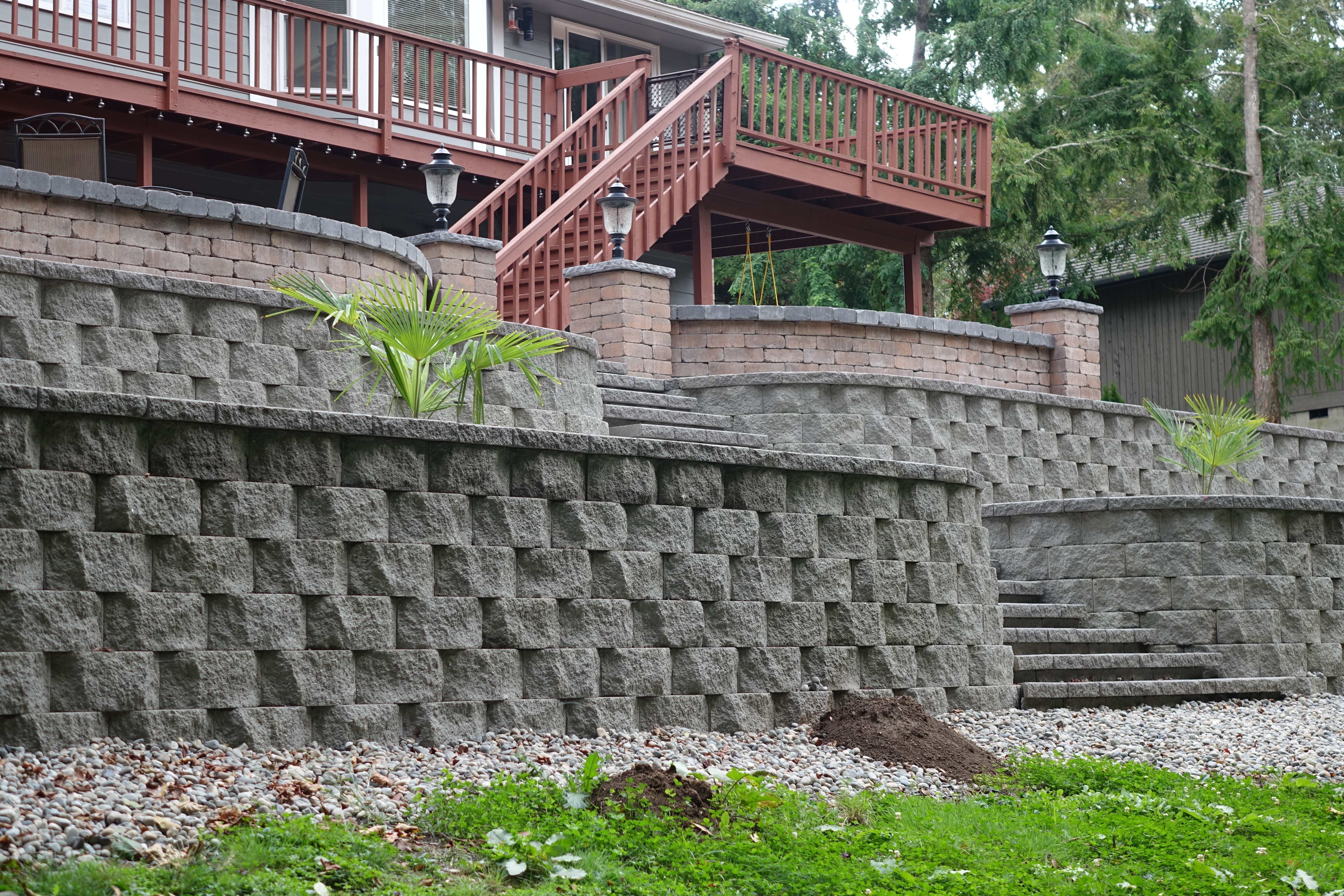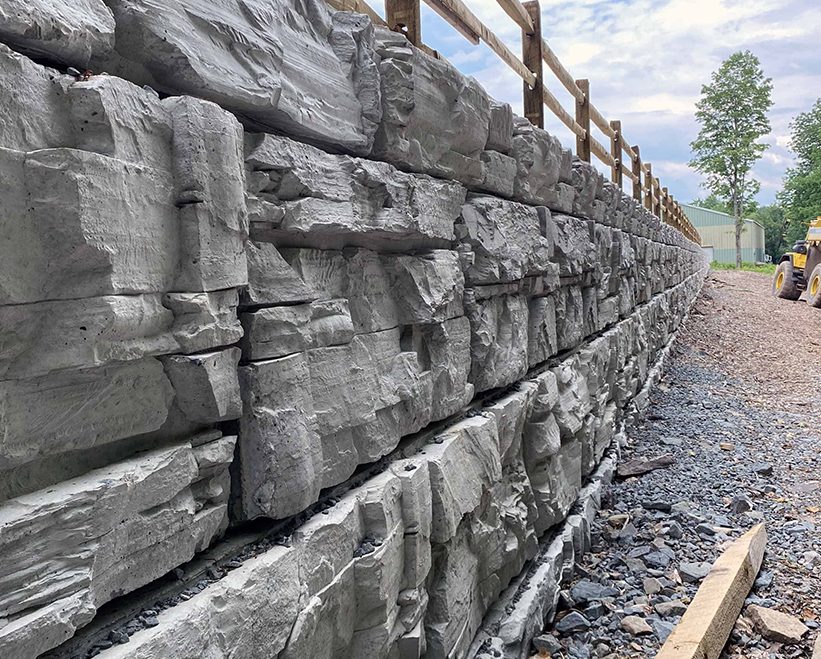Top retaining wall mistakes to avoid when working with OKC Precision Retaining Walls
The Vital Guide to Comprehending the Performance of Retaining Walls
When it concerns managing sloped landscapes, retaining walls are necessary. They not only keep back dirt however additionally stop erosion and protect your property from prospective landslides. Understanding their functionality can help you make informed choices regarding style and upkeep. However what kinds of retaining walls are readily available, and exactly how do you select the right materials? Let's explore these crucial considerations better.
What Are Retaining Walls and Their Function?
Retaining walls are vital structures made to hold back dirt and stop disintegration, particularly on sloped landscapes. They offer stability to your residential or commercial property, ensuring that dirt stays in position and stopping potential landslides. When you consider a preserving wall, consider its function in managing water overflow, which can wear down dirt gradually. Without these walls, you might encounter expensive damages to your landscape and foundation.
Additionally, retaining walls can develop usable areas in your backyard. By leveling out a sloped location, you can gain a lot more useful outdoor room for horticulture, patios, or play areas. The design and materials you select can enhance your home's aesthetics, making it visually appealing.
Ultimately, understanding the function of retaining walls aids you appreciate their value in landscape administration (OKC Precision Retaining Walls). They not just secure your building but likewise add to the overall beauty and functionality of your exterior area
Kinds Of Retaining Walls: An Overview
When it comes to managing soil and water overflow in your landscape, knowing the different types of retaining walls can help you make an enlightened option for your residential or commercial property. Gravity walls rely on their weight to hold back dirt, making them a durable alternative for smaller slopes. Cantilever walls, on the various other hand, utilize a lever-like layout, which permits them to support a lot more substantial lots with less material.
Secret Products Used in Retaining Wall Construction
To create a strong and reliable retaining wall surface, picking the right materials is crucial. You'll find that concrete is a preferred option because of its longevity and strength. Precast concrete obstructs offer flexibility in layout, while put concrete supplies a seamless appearance. If you like a more natural appearance, stone or brick can add aesthetic charm and blend with the landscape.
Wood is one more option, specifically for smaller sized walls, but maintain in mind it may not last as long because of degeneration. Steel and gabion walls, which make use of cable mesh full of rocks, are also reliable for certain circumstances. Each material has its own advantages and drawbacks, so consider your wall surface's function, location, and budget. Eventually, the right material will improve the wall's security and longevity, guaranteeing it satisfies your needs while standing the examination of time.

Style Factors To Consider for Effective Retaining Walls
Designing an efficient retaining wall involves careful consideration of several key variables, as the wall surface has to withstand both vertical and lateral pressures. Examine the soil type and its residential or commercial properties; cohesive soils act in different ways than granular ones. You'll additionally wish to establish the height of the wall, as taller walls need even more robust layout solutions.
Next, take into consideration water drainage. Correct water drainage protects against water accumulation behind the wall, reducing pressure and prospective failing. Incorporate weep openings or drain pipelines for effective water management.
Additionally, assume concerning the products you'll use. Various materials, like concrete, rock, or wood, deal differing staminas and appearances.
Finally, don't forget regional laws and codes. They frequently determine style criteria and building and construction techniques. By attending to these considerations, you can ensure your retaining wall surface is not just useful but also sturdy and risk-free.
Applications of Retaining Walls in Landscaping and Building
Retaining walls offer an essential duty in both landscaping and building, as they aid handle modifications in altitude and stop soil disintegration. In landscape design, you can use them to develop attractive terraced gardens, permitting you to maximize your exterior area while adding visual rate of interest. They likewise assist specify areas, such as pathways or blossom beds, enhancing your landscape's total layout.
In construction, retaining walls give stability to frameworks improved sloped land, guaranteeing security and sturdiness. They're frequently utilized in roadways and industrial buildings to manage planet movement and drainage successfully. By protecting against soil from shifting, retaining walls safeguard foundations and preserve the integrity of your structure jobs.
Whether you're aiming to boost visual appeal or guarantee structural security, retaining walls use sensible options that can greatly profit your landscape and construction ventures. Embrace their convenience to achieve both aesthetic and practical objectives.
Maintenance Tips for Long-Lasting Retaining Walls
To maintain your retaining walls in great shape, routine assessments and prompt repairs are essential. You also need to ensure proper drainage solutions to avoid water buildup, which can weaken the framework. Managing greenery around the walls will certainly aid maintain their integrity and expand their life-span.

Regular Maintenances
While you may think your retaining wall surface can stand strong on its very own, regular inspections and prompt repair services are crucial for its durability. Look for any type of moving in the soil bordering the wall surface, as this can show much deeper issues. By being positive about evaluations and repair work, you'll guarantee your retaining wall remains tough and functional for years to come.
Appropriate Drain Solutions
Efficient drain is vital for keeping the integrity of your retaining wall surface, as water buildup can lead to considerable structural problems. To ensure correct drainage, install weep openings at routine intervals along the wall surface. By implementing these solutions, you'll boost the durability and security of your retaining wall, safeguarding it against prospective damage triggered by water buildup.
Greenery Administration Techniques
Healthy and balanced greenery can play an important duty in the longevity of your retaining wall surface. Start by picking ingrained plants that assist stabilize the soil without triggering stress on the wall.
Keep the vegetation trimmed to stop excess weight and keep proper drainage. It's crucial to prevent overwatering, as excessive dampness can erode the wall surface's foundation. Additionally, consider utilizing compost to retain soil moisture while subduing weed development. By like it implementing these plants management techniques, you'll support your retaining wall surface's sturdiness and improve the surrounding landscape's beauty.
Usual Problems and Solutions for Retaining Walls
When it pertains to retaining walls, dirt disintegration and water drainage problems can cause significant migraines. You require to ensure your wall is correctly designed to stop disintegration and has a reliable drainage system in position. Let's explore some common troubles and their services to keep your retaining wall tough and practical.
Soil Erosion Prevention
Dirt disintegration can be a considerable difficulty for retaining walls, especially if not correctly attended to. When dirt wears down, it can threaten the wall surface's home stability, leading to prospective failures. By taking these proactive steps, you can substantially enhance the durability and effectiveness of your retaining wall surface against dirt erosion.
Water Drainage System Importance
A trusted drain system is essential for the performance and durability of retaining walls. Without appropriate drain, water can collect behind the wall surface, developing extreme stress that might cause architectural failure. You might see bulging or breaking, which indicates the requirement for prompt interest. To protect against these problems, think about setting up weep holes, which allow water to leave, or a perforated drain that redirects water away from the wall. Frequently look for clogs in your drain system, as particles can hinder its efficiency. Keeping appropriate water drainage not only safeguards your retaining wall surface however also ensures the bordering landscape remains secure. By staying aggressive, you can avoid costly repairs and lengthen the life of your retaining wall surface.
Frequently Asked Questions
Just How Do Retaining Walls Influence Drainage Solutions?
Retaining walls can considerably influence drain systems by redirecting water circulation. They prevent soil disintegration and take care of groundwater degrees, making certain stability. If you're preparing building, think about exactly how they'll engage with your drain style for excellent outcomes.
Can Retaining Walls Be Set Up on Slopes?
Yes, you can mount retaining walls on slopes. They assist support the soil and prevent erosion. Just assure appropriate drainage and select the appropriate materials to handle the pressure from the soil behind the wall.
What Is the Life-span of a Normal Retaining Wall Surface?
A common retaining wall lasts around 20 to half a century, relying on materials, upkeep, and ecological conditions. You should regularly inspect it to ensure its long life and deal with any concerns without delay to prevent pricey repair work.
Are Allows Required for Building Retaining Walls?
Yes, you usually require licenses for developing retaining walls. Check your local building regulations and laws to assure compliance. It's vital to safeguard the appropriate consents before beginning your project to prevent prospective penalties or concerns.
Exactly How Do Retaining Walls Impact Residential Property Worth?
Retaining walls can why not try these out positively impact your home value by boosting aesthetic appeals, avoiding erosion, and producing usable outdoor room. OKC Precision Retaining Walls. They also demonstrate great land monitoring, making your building extra attractive to prospective purchasers out there